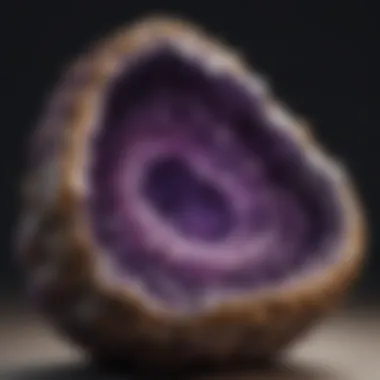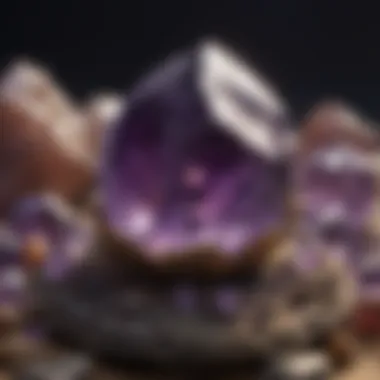Exploring the Mystique of Amethyst: A Comprehensive Guide


Intro
Amethyst, a stunning purple crystal, has captivated individuals for centuries. Its allure stems not only from its vibrant color but also from its rich history and wide array of uses. This article aims to provide a comprehensive guide to understanding amethyst, including its geological formation, variations, and cultural significance.
Whether you are a seasoned collector, a crystal enthusiast, or simply someone intrigued by amethyst's properties and lore, the following sections will enlighten you.
From its geological roots to its modern-day applications, amethyst serves as a fascinating subject to explore. We will examine its unique characteristics and the cultural context that enhances its value.
Rock and Fossil Identification
Understanding rock and fossil identification is essential for anyone involved with collecting. While the focus here is on amethyst, knowing how to identify various forms of rock can enhance the experience of a crystal enthusiast.
Types of Rocks and Fossils
- Igneous Rocks: Formed from cooled magma, examples include granite and basalt.
- Sedimentary Rocks: Created from sediment accumulation, such as limestone and sandstone.
- Metamorphic Rocks: Formed under heat and pressure, like marble and schist.
Identification skills can be crucial. Check these characteristics:
Characteristics to Look For
- Color: Amethyst typically showcases shades from light lavender to deep purple.
- Clarity: Transparency varies; some have notable inclusions.
- Luster: The surface shine can indicate quality.
To assist in rock identification, both amateur and seasoned collectors often require tools.
Tools for Identification
- Magnifying Glass: Helps observe fine details.
- Rock Hammer: For extracting samples.
- Field Guides: Useful for reference on various rock types.
Prologue to Amethyst
Amethyst is not just a beautiful crystal; it embodies a rich tapestry of characteristics and significance that precede its visual appeal. This section introduces readers to the multifaceted nature of amethyst, which serves as a vital foundation for understanding the mineral's broad implications in geosciences and culture.
The importance of exploring amethyst stems from its role in both natural and anthropogenic contexts. For rock and fossil collectors, amethyst offers a glimpse into geological formations and processes, making its study relevant not only for appreciation but also for understanding the Earth’s history. Moreover, the crystal's cultural significance further elevates its status, revealing layers of human interaction with this striking mineral.
Amethyst has been revered for centuries, and this admiration is not solely due to its indigo hues. The crystal’s various properties, from its unique formation process to its historical uses, illustrate the interplay of geology and human culture. Collectors and enthusiasts alike will find value in understanding amethyst's definition, origins, and perhaps its ethereal presence in both past and present.
Definition and Overview
Amethyst is a purple variety of quartz, composed mainly of silicon dioxide (SiO2). The presented hues can range from light lavender to deep violet, influenced by iron and other trace elements in the crystal structure. Amethyst crystallizes in the hexagonal system, typically forming prismatic shapes, which can be found in sizable clusters. This geological phenomenon occurs under specific conditions, allowing for the development of these unique crystals.
This mineral is most distinguished by its captivating color and enchanting luster. Because of its mesmerizing visual properties and widespread availability, amethyst has found a significant place in the jewelry industry, art, and healing traditions around the world. It serves not only as a decorative piece but also as a subject of study for mineralogy enthusiasts, reflecting light in ways that capture the eye and spark curiosity.


Etymology of ‘Amethyst’
The word "amethyst" derives from the Greek word "amethystos,” meaning "not intoxicated." Ancient Greeks believed that wearing this stone would prevent drunkenness and clear the mind. This historical perspective adds a layer of mystique and cultural significance to the crystal, offering insight into ancient belief systems.
As a word, amethyst entered the English lexicon in the 14th century, demonstrating its long-standing prevalence in historical narratives. Its etymology not only connects the crystal to ideas of sobriety and clarity but also to the ancient practice of gemology. This connection highlights the depth of knowledge that has evolved through the ages concerning this particular mineral.
Geological Characteristics
The geological characteristics of amethyst play an essential role in understanding its formation, occurrence, and significance. This section delves into how amethyst is formed within the Earth, the conditions that are necessary for its creation, and the specific locations that produce high-quality specimens. Recognizing the geological factors allows collectors and enthusiasts to appreciate the unique attributes of amethyst. Furthermore, understanding geological characteristics informs choices regarding buying or collecting strategies, as different deposits can yield distinct qualities of the stone.
Formation Process of Amethyst
Amethyst is a variety of quartz that contains iron and trace elements. The formation process begins when volcanic activity leads to the emergence of amethyst in cavities within volcanic rock. As lava cools, gases can become trapped, creating pockets where mineral solutions accumulate. These solutions react within the cavity, and as temperatures drop, silica crystallizes into quartz. The unique purple color of amethyst is due to the presence of iron ions. During oxidation of these ions, various shades of purple develop, which can range from pale lavender to deep violet, depending on the concentration of iron and the level of exposure to radiation.
The conditions under which amethyst forms vary significantly, but they generally require specific temperature and pressure ranges. Collectors often seek out these formations because the environment produces distinctive crystals.
Key Locations for Amethyst Deposits
Several regions around the world are renowned for their amethyst deposits. Each location has unique characteristics that influence the quality and appearance of the amethyst produced.
Brazil
Brazil is one of the largest producers of amethyst globally. The key characteristic of Brazilian amethyst is its vibrant color and often, larger-sized crystals. The Serra do Mar region is particularly noted for its high-quality specimens. One noteworthy feature is the vast quartz geodes found in the region, sometimes containing stunning clusters of amethyst. The benefits of Brazilian amethyst include availability and variety, making it an attractive choice for buyers. Yet, certain mines have seen declining yields.
Uruguay
Uruguay is celebrated for its rich deposits of amethyst in the Artigas region. The amethyst from this country is known for its deep, saturated colors and clarity, often described as some of the finest in terms of quality. The unique geological features in Uruguay contribute to the formation of small, but remarkably potent crystals. Collectors often favor these for their pronounced hues. However, it is worth noting that because of high demand, prices can be elevated.
South Africa
In South Africa, amethyst deposits are found in areas such as the Northern Cape. The stones here are characterized not only by their color but also by their crystal formations, which can include unusual shapes and growth patterns. South African amethyst is commonly sought for jewelry making due to its aesthetic appeal. However, the supplies are intermittent, which can make sourcing consistent quality more challenging for collectors.
United States
The United States has diverse amethyst sources, with significant deposits found in places like Arizona and Georgia. Notably, Arizona amethyst tends to be lighter in color but can also display unique banding or zoning within the crystals. This regional variation provides collectors an opportunity to explore different qualities of amethyst. While local sources are accessible, they sometimes lack the historical depth found in South American deposits, which may affect collector interest.
Collecting amethyst means appreciating the nuances of its formation, location, and diversity in natural characteristics.
Physical Properties
The physical properties of amethyst are crucial for understanding its value and appeal. This purple crystal is not only beautiful but also possesses attributes that enhance its desirability among collectors and enthusiasts. Knowing the physical characteristics can assist in both appreciating amethyst and ensuring its authenticity.
Color Variations and Causes


Amethyst displays a spectrum of color variations, primarily ranging from light lavender to deep violet. These colors are caused by the presence of iron and other trace elements during the crystal's formation. The color intensity may vary based on factors such as the level of radiation exposure and the specific conditions under which the quartz developed.
The most sought-after amethyst features a deep, rich purple hue. It is also interesting to note that color can be influenced by the source of the amethyst. For example, Brazilian amethyst tends to exhibit a more uniform color, while Uruguayan specimens can show more gradient tones, making them unique.
"The color of amethyst not only determines its beauty but also its worth in the market," remains a significant point among collectors.
Hardness and Luster
Amethyst ranks 7 on the Mohs scale of mineral hardness. This means it is relatively durable and can withstand everyday wear when used in jewelry. This hardness contributes to its utility in various applications, including rings, bracelets, and necklaces. The luster of amethyst is typically vitreous, offering a glassy finish that enhances its visual appeal.
For collectors, understanding these properties is vital. A well-cut amethyst will reflect light beautifully, and its toughness means it can be a worthwhile investment. When assessing the quality, factors like the cut, clarity, and finish can influence its final value.
Identifying genuine amethyst also requires knowledge about its hardness. Many imitations exist in the market, and they often do not share the same durability. Collectors must be cautious and use available testing techniques to ensure they acquire authentic pieces.
Cultural Significance
The cultural significance of amethyst extends across various civilizations and periods, showcasing its multifaceted role in human history. It serves as a lens through which one can understand not just the mineral itself but also the societies that cherished it. This section aims to elucidate how amethyst has been intertwined with historical uses and modern relevance. Understanding these aspects is vital for collectors and enthusiasts, as it enriches the narrative of the mineral's journey through time.
Historical Uses of Amethyst
Ancient Civilizations
In ancient civilizations, amethyst was more than a decorative stone; it was imbued with profound meaning. The Egyptians utilized amethyst in their jewelry and burial artifacts. They believed that the crystal could protect against intoxication and promote wisdom. This unique feature highlights the value ancient societies placed on gemstones as conduits of both power and protection. The prominence of amethyst in these cultures attests to its enduring place in human appreciation for beauty and significance.
Royalty and Status
Throughout history, amethyst has been a symbol of royalty and status. Monarchs adorned themselves with amethyst jewels, showcasing their wealth and power. Notably, the British Crown Jewels incorporate amethyst, linking the crystal to governance and authority. The rich purple hue of the stone is often associated with nobility and luxury. This characteristic makes amethyst a significant subject in studies of social hierarchies and material culture.
Religious Symbolism
Amethyst also carries deep religious symbolism. Many religious groups consider it sacred. In Christianity, amethyst is regarded as a stone that represents humility and piety. This quality makes it popular in various religious artifacts, including crosses and rosaries. The unique feature of amethyst serving as a bridge between the divine and the earthly realm highlights its importance not just architecturally, but spiritually.
Amethyst in Modern Culture
Jewelry and Fashion
In modern culture, amethyst continues to be a prominent choice in jewelry and fashion. Its striking color and affordability make it appealing to a broad audience. Many designers use amethyst in contemporary designs, further cementing its status as a timeless gem. This expanding use in fashion emphasizes how cultural narratives around amethyst have evolved while maintaining its allure.
Spiritual Practices
Amethyst is also significant in various spiritual practices. Many practitioners use the stone for meditation and energy work. It is believed to promote tranquility and clarity of mind. This aspect of amethyst contributes to the growing interest in holistic health approaches, making it relevant in today’s wellness discourse. Such practices invite further exploration of the stone’s metaphysical properties.


Wellness and Healing
Lastly, in the realm of wellness and healing, amethyst is often associated with stress relief and emotional balance. Crystal healing enthusiasts advocate for its calming effects, believing it helps to alleviate anxiety. This characteristic highlights a shift towards integrative health solutions, where natural stones like amethyst play a key role. It prompts a conversation about the intersection of tradition and modern wellness practices, stimulating interest in the natural attributes of gemstones.
Amethyst's rich history and versatility make it a valuable subject for collectors, scholars, and enthusiasts alike. Understanding its cultural significance provides a deeper appreciation of this remarkable mineral.
Amethyst in Collecting
Collecting amethyst can be an enriching experience, both personally and financially. Enthusiasts value amethyst for its beauty and perceived metaphysical properties. Collectors appreciate the challenge of finding unique pieces and the joy that comes with enhancing their collections. It is vital for collectors to understand the qualities that define high-quality amethyst, as well as to develop best practices when acquiring pieces.
Collecting Amethyst: Best Practices
When collecting amethyst, a few best practices can make a significant difference in the quality and value of the collection. First, understanding the origin of the pieces is crucial. Brazilian amethyst, for example, often exemplifies deep purple hues, while Uruguayan amethyst can portray a more vibrant color.
Another important aspect is preservation. Proper storage prevents scratches and damage. Displaying amethyst in a secured and controlled environment helps maintain its condition. Additionally, maintaining a record of pieces is beneficial. Documenting the history of each piece adds to its narrative and potential value.
Identifying Genuine Amethyst
Identifying authentic amethyst is essential for any collector. Knowing how to distinguish between genuine and imitation stones can have lasting ramifications on the collection.
Common Imitations
Common imitations of amethyst can catch even seasoned collectors off guard. One prevalent imitation is heat-treated quartz. In this case, the treatment alters the stone’s color to mimic amethyst. Most often, it is more affordable and marketed as an alternative. Recognizing this imitation is critical. It may lack the depth of color found in natural amethyst. Being aware of these common pitfalls is essential for informed purchasing.
Testing Techniques
Employing testing techniques is necessary to ensure the authenticity of amethyst. One technique involves examining clarity and luminosity under direct light. Real amethyst has a unique internal structure that can be observed this way. Another useful approach is the scratch test, where genuine amethyst rates a seven on the Mohs scale of hardness. Always consider that while these techniques aid in identification, consulting professional gemologists can provide the best verification.
"Understanding amethyst's characteristics is vital for collectors to make informed choices."
Closure
The conclusion serves as an essential component of this article, encapsulating the intricate nature of amethyst. Understanding this crystal goes beyond mere aesthetics; it opens a window into its geological formation, cultural significance, and various applications throughout history. Amethyst is not just a beautiful stone but a subject of rich study that connects geology, history, and modern practices.
Recap of Amethyst’s Importance
Amethyst has held a prominent position in many cultures due to its appealing color and attributed properties. Historically, it was used by ancient civilizations such as the Greeks and Romans, who believed it to be a safeguard against intoxication. Additionally, the stone has been associated with spirituality, often being used in rituals and meditation practices.
Today, its significance persists. Amethyst is widely recognized in the fields of jewelry making and wellness. Many people utilize this stone for its purported healing properties and for enhancing personal well-being. Moreover, its geological significance, particularly in defining locations like Brazil and Uruguay, adds value for collectors.
"Amethyst is not just a crystal; it embodies a link to human history and culture, serving both aesthetic and practical purposes."
Encouragement for Further Study
For those captivated by the world of crystals, exploring amethyst can lead to a broader understanding of geology and its implications on our lives. Delving into subfields such as crystal healing and mineral collecting can enrich one's perspective.
Consider joining forums or communities, such as those on Reddit, where discussions effectively unravel the nuances of amethyst and its counterparts. Engaging with academic articles, particularly detailed resources like those found on Britannica, can provide comprehensive knowledge for collectors and enthusiasts alike.
By pursuing further study, one can discover the depth of amethyst beyond its visual appeal, appreciating the various facets that make this crystal truly remarkable.







